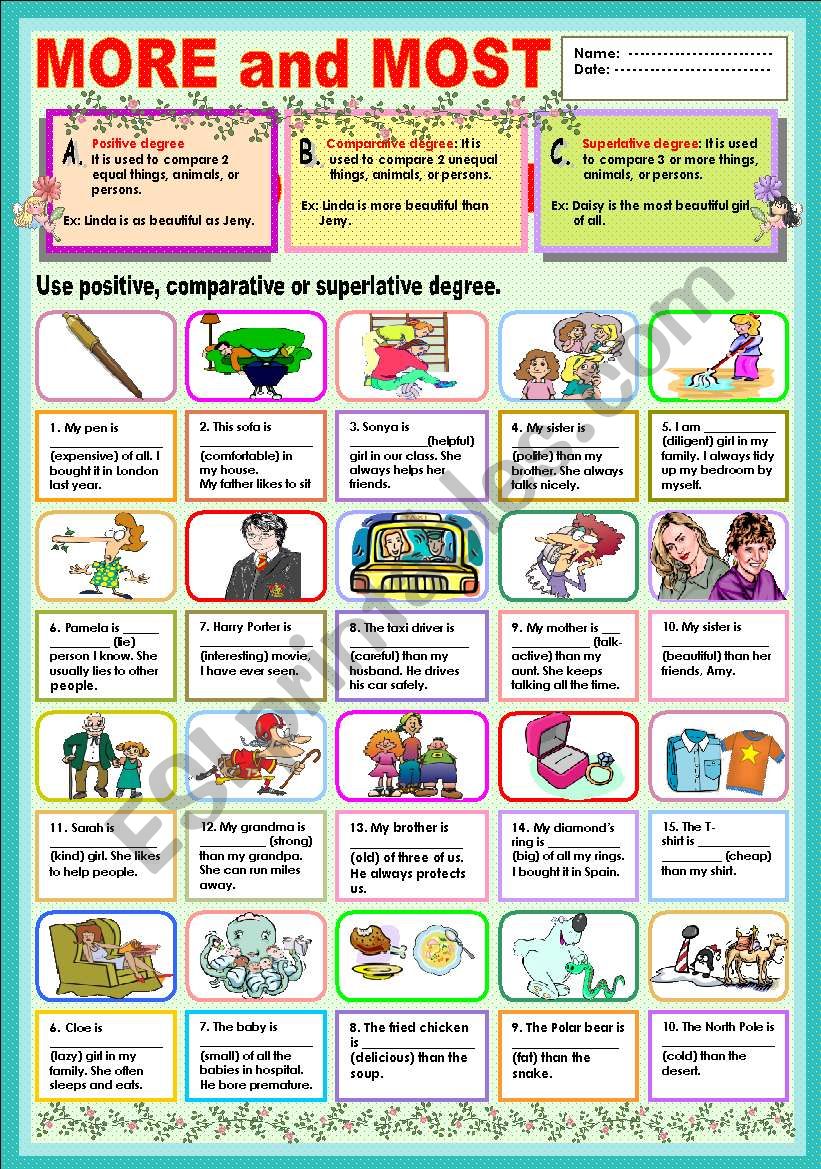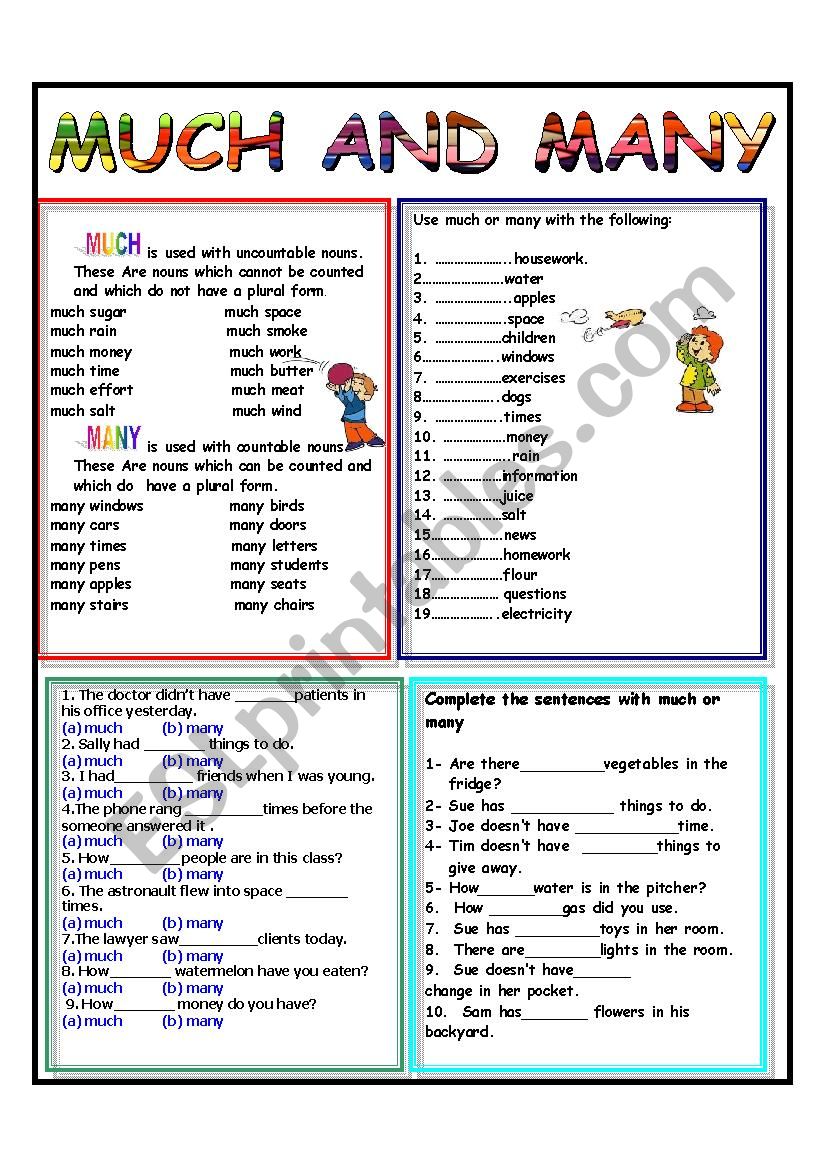
Mastering Comparatives and Superlatives: The Indispensable Role of Much More Most Worksheets
In the journey of mastering the English language, grasping the nuances of comparative and superlative adjectives and adverbs is a pivotal step. These grammatical structures allow us to express differences and extremes, adding depth and precision to our communication. While the core concepts of "bigger," "fastest," "more beautiful," and "most intelligent" are foundational, the strategic use of intensifiers like "much" before comparatives, and the correct application of "more" and "most" across various word types, often presents a challenge for learners. This is precisely where the utility of a well-designed much more most worksheet cannot be overstated – it serves as an indispensable tool for reinforcing, practicing, and ultimately, internalizing these crucial grammatical patterns.
This article delves into the significance of comparatives and superlatives, explores the specific roles of "much," "more," and "most," and highlights why comprehensive worksheets dedicated to these structures are vital for both language acquisition and pedagogical success.
The Core Mechanics: Comparatives and Superlatives

Before exploring the role of worksheets, it’s essential to solidify the foundational grammar:

- Comparatives: Used to compare two things.

- For most one-syllable adjectives/adverbs: add "-er" (e.g., tall -> taller, fast -> faster).
- For adjectives/adverbs ending in -y: change -y to -i and add "-er" (e.g., happy -> happier, easy -> easier).
- For most two-syllable adjectives/adverbs and all three-or-more syllable words: use "more" before the adjective/adverb (e.g., beautiful -> more beautiful, difficult -> more difficult, carefully -> more carefully).

- Superlatives: Used to compare three or more things, indicating the extreme.

- For most one-syllable adjectives/adverbs: add "-est" (e.g., tall -> tallest, fast -> fastest). Always preceded by "the."
- For adjectives/adverbs ending in -y: change -y to -i and add "-est" (e.g., happy -> happiest, easy -> easiest). Always preceded by "the."
- For most two-syllable adjectives/adverbs and all three-or-more syllable words: use "most" before the adjective/adverb (e.g., beautiful -> most beautiful, difficult -> most difficult, carefully -> most carefully). Always preceded by "the."


- Irregular Forms: A critical aspect often targeted by worksheets are the irregular forms that don’t follow the rules (e.g., good -> better -> best; bad -> worse -> worst; far -> farther/further -> farthest/furthest; little -> less -> least; much/many -> more -> most).


The Specific Roles of "Much," "More," and "Most"
Understanding the core mechanics behind much more most worksheet exercises is paramount for effective learning. While "more" and "most" are directly part of forming comparatives and superlatives for multi-syllable words, "much" plays a distinct, yet equally important, role.
-
"More": The Comparative Adjective/Adverb Former
- As established, "more" precedes adjectives and adverbs with two or more syllables (excluding those ending in -y) to form their comparative degree.
- Examples: more exciting, more quickly, more important.
- It’s crucial for learners to differentiate between when to use "-er" and when to use "more." A common error is "more faster" instead of "faster," or "more easier" instead of "easier."
-
"Most": The Superlative Adjective/Adverb Former
- Similarly, "most" precedes adjectives and adverbs with two or more syllables (excluding those ending in -y) to form their superlative degree. It is always used with "the."
- Examples: the most exciting, the most quickly, the most important.
- Just like with "more," learners must avoid "the most fastest" or "the most easiest."
-
"Much": The Intensifier for Comparatives
- This is where "much" adds a layer of sophistication. "Much" is used before a comparative adjective or adverb to emphasize a significant difference. It indicates that the difference is large, not small.
- Examples:
- "This car is much faster than that one." (Not just a little faster, but a significantly faster.)
- "Her new house is much bigger than her old one."
- "He learns much more quickly than his classmates."
- "The test was much more difficult than I expected."
- Other intensifiers like "a lot," "far," "a great deal," and "significantly" can also be used similarly, but "much" is particularly common and versatile. This usage is often a point of confusion for students and is therefore a prime candidate for targeted practice within a worksheet.
Why "Much More Most Worksheets" Are Essential Learning Tools
The practical applications of much more most worksheet in reinforcing these concepts are manifold, making them indispensable for language educators and self-learners alike.
-
Reinforced Practice: Language acquisition thrives on repetition. Worksheets provide structured, repetitive exercises that solidify the rules in a learner’s mind. Through varied drills, students repeatedly encounter and apply the correct forms.
-
Identification of Patterns and Rules: By presenting various scenarios, worksheets help students identify the patterns for forming comparatives and superlatives (e.g., the number of syllables, the ending of the word). They learn to differentiate when to add "-er/-est" versus when to use "more/most."
-
Addressing Common Errors: As mentioned, mistakes like "more faster" or "most biggest" are rampant. Worksheets can specifically target these common pitfalls through error correction exercises or by designing questions that subtly guide students towards the correct structure. Exercises focusing on "much" will ensure students use it correctly to intensify comparatives, rather than misusing it with superlatives or base forms.
-
Variety of Exercise Types: A good much more most worksheet goes beyond simple fill-in-the-blanks. It can include:
- Sentence Completion: Fill in the blank with the correct comparative or superlative form.
- Sentence Transformation: Rewrite sentences using a comparative or superlative.
- Multiple Choice: Select the correct form from given options.
- Error Correction: Identify and correct grammatical errors in sentences.
- Contextual Paragraphs: Complete a story or description using appropriate comparative/superlative forms based on context.
- Comparison Charts: Fill in charts comparing different items or people.
- Open-Ended Questions: Encourage students to write their own comparative or superlative sentences.
-
Differentiation and Progression: Worksheets can be designed with varying levels of difficulty, catering to beginners, intermediate, and advanced learners. Early worksheets might focus solely on regular forms, while later ones introduce irregulars, the use of "much," and more complex sentence structures.
-
Self-Correction and Immediate Feedback: Many worksheets come with answer keys, allowing students to check their work immediately. This instant feedback is crucial for self-correction and understanding where errors occurred, preventing the reinforcement of incorrect patterns.
Designing and Implementing Effective "Much More Most Worksheets"
Creating an effective much more most worksheet demands pedagogical insight and careful consideration of learner needs.
- Clear Instructions: Ensure that instructions are simple, concise, and unambiguous. Students should know exactly what is expected of them.
- Gradual Complexity: Start with the basics (e.g., one-syllable adjectives, regular forms) before moving to more complex structures (multi-syllable words, irregulars, and finally, the intensifier "much").
- Contextual Relevance: Use examples that are relatable and interesting to the target audience. Comparing daily objects, famous people, places, or common activities makes the exercises more engaging and meaningful.
- Visual Aids: Incorporate pictures or simple diagrams, especially for younger learners or visual learners, to make comparisons concrete.
- Inclusion of "Much": Dedicate specific sections or exercises to the use of "much" with comparatives. Provide examples that clearly illustrate the difference between "a little faster" and "much faster."
- Irregular Forms Emphasis: Always include ample practice for irregular forms, as these are often memorized rather than rule-based.
- Mix of Productive and Receptive Tasks: Include tasks where students produce the correct forms (fill-in-the-blanks, sentence creation) and tasks where they recognize them (multiple choice, error correction).
- Beyond the Worksheet: Encourage students to apply these structures in speaking and writing activities. For instance, after completing a worksheet, have them compare two objects in the classroom, describe the "most" interesting thing they did last week, or debate which animal is "much smarter" than another.
Conclusion
The ability to compare and contrast, to express degrees of difference and extremes, is fundamental to effective communication in English. While the rules governing comparatives and superlatives can seem intricate, especially with the added layer of intensifiers like "much," dedicated practice is the key to mastery.
A well-constructed much more most worksheet is far more than just a series of exercises; it is a meticulously designed learning tool that guides students through the complexities of these grammatical structures. From reinforcing the basic "-er/-est" and "more/most" rules to specifically targeting the nuanced use of "much" for emphasis, the enduring value of a comprehensive much more most worksheet remains undeniable. By providing structured practice, addressing common errors, and offering a variety of engaging tasks, these worksheets empower learners to confidently and accurately wield the power of comparison in their English communication, paving the way for greater fluency and precision.
